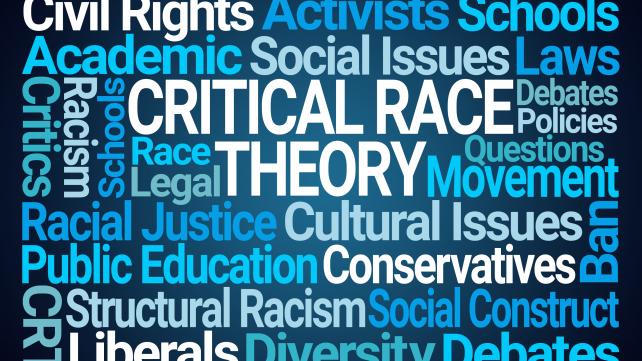CRT Hysteria – A Cyclical Dispute
By Mahasin D. Shamsid-Deen
Chicago, IL

Critical Race Theory (CRT) is controversial to some Americans. To others, it is a lived experience. CRT itself is a legal and academic concept that examines the existence and impact of racism in America’s institutions, systems and culture. Racism is discrimination leading to oppression. Oppression itself is unjust treatment or control. When the life experiences of people are doubted or deemed not valuable, this is a state of oppression.
The current CRT hysteria really stems from an Executive Order issued by then-President Donald Trump in September 2020 that excluded federal contracts that addressed any diversity and inclusion training interpreted as containing “Divisive Concepts,” “Race or Sex Stereotyping,” and “Race or Sex Scapegoating.” Among the content considered “divisive” was Critical Race Theory.
By January 2022, about 22 states had banned or were in the process of banning CRT concepts being taught. Instructors on both the college and public school level found their jobs placed in jeopardy or lost tenure if they taught CRT concepts. Some instructors rallied for their right “not” to teach CRT if it were part of the curriculum. Parents demonstrated at schools that teach CRT in an attempt to change legislative policy. The number of parents opting for home schooling or private schools increased. Even Virginia’s newly elected governor advised parents to “turn in” teachers who taught “controversial” subjects.
But this hoopla is not a new issue. It is a more recent manifestation of an historical problem and should not be reduced down to just “white” discomfort with academic lessons that address errors, and wrongs of the past.
As the attempts to subvert CRT increase, the atmosphere of unfairness clouds the sensibilities on both sides. When emotions run high, there is a clear suppression of civil public discourse and exchange of ideas. People become frightened by what they don’t understand or give in to irrational fears fanned by misinformation. The extent to what actions the opposing sides of CRT will do is inestimable.
Let’s step back in history for a moment and look at one school that was involved in the Brown v. Board of Education landmark Supreme Court decision. In May of 1959, the Prince Edward County School system in Virginia was ordered by two courts to integrate its schools. Rather than follow the court order, the Virginia Board of Supervisors refused to appropriate money from the County School Board to the public schools. Thus, the entire public-school system shut down. In fact, officials in Prince Edward created private schools to educate the county's White children. These schools were supported by tuition grants from the state and tax credits from the county.
For five years the Prince Edward County Board of Supervisors refused to fund public schools. It was part of what was known as the Massive Resistance Movement. Due to the Brown v. Board of Education decision, schools in the South and other parts of the nation reacted with resistance and in some cases, violence. In Virginia at the time, Senator Harry Byrd issued a “Southern Manifesto” calling for “Massive Resistance” to school integration. The manner in which policy was resisted varied from state to state, but in Virginia this included closing schools designated for integration, school board refusal to assign Black students to previously all-White schools, teachers forbidden to teach Black students in integrated classrooms, White students issued vouchers for segregated private schools, tax credits for parents who sent their children to segregated schools and the movement even allowed teachers who chose to work at segregated private schools to maintain their public school credit and retirement plan.
The most tragic impact of this movement was on the education and psyche of African-American children at the time. For more than five years, these African-American students had no public school available to them. Imagine the impact on these students to lose five of their twelve years of education. In response to this tragedy, local churches and the Quakers opened their doors to establish private education for African-American children. Naturally, this was accomplished solely through local donations as the parents of African-American students did not receive “vouchers” or tax credit for putting their child in a private school.
It wasn’t until 1964 that the US Supreme Court ordered Prince Edward Schools to reopen. Even though the schools had been ordered to be desegregated, no real progress was made until after 1968 when another lawsuit forced the school board’s hand. In the 1970s, most of Virginia’s urban schools were segregated and even in 2020, a study conducted by Virginia Commonwealth University revealed that school boundaries drawn in the state support racial and economic segregation.
The draconian measures to prevent CRT in the present day are comparable to these struggles in the past and are a part of America’s history. Children of Chinese immigrants were denied a state-funded education until 1885. In 1860 US-funded Native American boarding schools were established. Mexican-American students didn’t have educational access until the 1880s. Laws restricting African-American education provided severe punishment until after the Emancipation proclamation. One consistency across all ethnic groups was school systems that openly sought to take away the culture and history of these students from the American narrative.
Interestingly, if CRT is not included in the school curriculum, historical facts like the actions of the Prince Edward County School Board or subversion of cultural identities of America’s minorities in academia could become “obscure” history. Americans would miss an opportunity to really know and appreciate the contributions of all its citizens. Perhaps, opponents to CRT should consider that this would be the most “divisive” of all.

